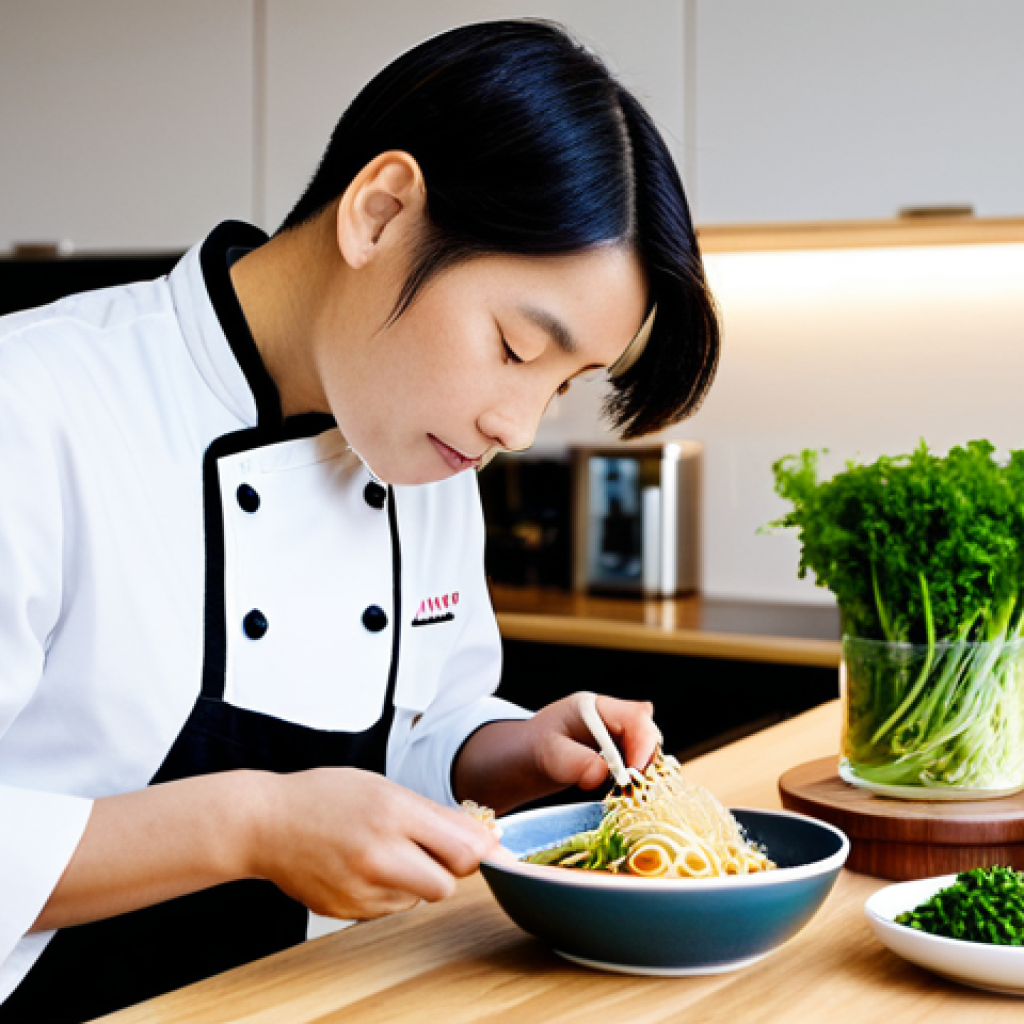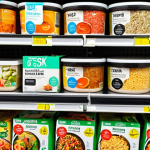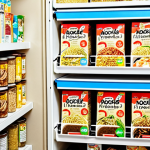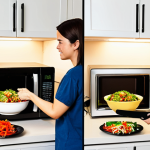Let’s be honest, we’ve all been there: staring into the pantry after a marathon day, too tired to even think about cooking. That’s when instant food, once a guilty pleasure, truly becomes a lifesaver.
But when you’re grabbing that quick fix, have you ever paused to wonder about the company behind it? I certainly have. Having personally navigated the dizzying array of options on grocery shelves, from gourmet instant noodles to surprisingly satisfying ready-to-eat meals, I’ve learned that not all convenience is created equal.
The landscape of instant food is constantly evolving, driven by an interesting mix of consumer demand for both speed and genuine quality. We’re talking about a fascinating shift where people aren’t just reaching for whatever’s cheapest; they’re looking for cleaner labels, sustainable packaging, and even plant-based alternatives.
It’s a real battleground, with some manufacturers truly innovating with AI-driven personalized nutrition or sourcing directly from vertical farms, while others seem stuck in the past, struggling with ingredient transparency and perceived unhealthiness.
Understanding these differences isn’t just about making a better quick meal choice; it’s about seeing the future of food unfold, one convenient bite at a time.
Let’s unearth the nuances together.
The Evolving Palate: From Guilty Pleasure to Gourmet Choice

For years, instant food carried a quiet shame, something we’d grab late at night when no one was looking, a culinary secret. But oh, how the tides have turned!
What I’ve personally witnessed on grocery shelves, and what I’ve been thrilled to experience in my own kitchen, is a complete transformation. It’s no longer just about survival; it’s about surprising delight.
I remember the days when “instant noodles” meant one or two rather uninspired options. Now, walking down that aisle feels like an adventure, a genuine exploration of flavors and textures I never thought possible from a packet or a tray.
Companies are truly stepping up their game, investing heavily in research and development to create instant meals that don’t just fill you up, but genuinely satisfy.
They’re hiring proper chefs, sourcing better ingredients, and pushing the boundaries of what ‘convenient’ can actually taste like. This shift is profound because it speaks to a deeper consumer desire: we want convenience, yes, but we absolutely refuse to compromise on quality or taste anymore.
It’s like discovering a hidden gem, where a quick meal can actually be a moment of genuine enjoyment rather than just a quick fix before collapsing into bed.
This is where the magic truly begins to happen, transforming the perception of what instant food can be.
The Rise of Artisanal Instant Meals
It’s genuinely exciting to see how many brands are now focusing on creating “artisanal” instant meals. When I first heard the term, I was skeptical, picturing just a fancier packet with the same old blandness.
But I was genuinely proven wrong. I’ve tried instant risottos that genuinely transport me to Italy, and ready-to-eat curries that pack an authentic punch of spices.
These aren’t just scaled-up versions of basic recipes; they often involve slow-cooked components, intricate spice blends, and higher-quality proteins or vegetables.
For example, some brands are now flash-freezing individually portioned gourmet sauces or pre-seared meats, which makes assembly at home not only quick but also incredibly fresh-ttasting.
It feels like these companies have finally understood that the modern consumer, even when pressed for time, still yearns for something that tastes like it was lovingly prepared.
It’s a testament to their innovation that they can deliver this experience in such a convenient format.
Chef-Inspired Creations for the Busy Bee
One of the most thrilling developments I’ve observed is the collaboration between instant food manufacturers and actual, renowned chefs. It’s no longer just food scientists in labs; real culinary artists are being brought in to develop recipes and flavor profiles.
I vividly recall picking up an instant ramen kit co-created by a Michelin-starred chef – my curiosity was piqued, and honestly, the experience blew my expectations out of the water.
The broth was rich and complex, the noodles had a surprisingly good chew, and the dehydrated toppings rehydrated beautifully, adding texture and freshness.
This trend isn’t just a marketing gimmick; it’s a genuine effort to infuse culinary expertise into mass-produced convenience. These chefs bring their understanding of flavor balance, ingredient synergy, and presentation, translating complex restaurant dishes into simplified, yet still delicious, instant formats.
It truly elevates the entire category, making it feel less like a last resort and more like a deliberate, satisfying choice.
Decoding the Label: Transparency and Health Consciousness
There was a time when grabbing an instant meal meant bracing yourself for a laundry list of unpronounceable ingredients, sodium levels that would make your doctor wince, and an unsettling amount of artificial colors.
I confess, I used to just close my eyes and pick, prioritizing speed over everything else. But my perspective, and that of countless others, has drastically shifted.
We’re now a generation of label readers, scrutinizing every single ingredient, dissecting nutritional panels, and demanding to know exactly what we’re putting into our bodies.
This heightened health consciousness has put immense pressure on instant food companies, forcing them to pivot dramatically. They can no longer hide behind vague terms or obscure additives.
The demand for “clean labels”—fewer, recognizable ingredients, free from artificial anything—is not just a trend; it’s a fundamental consumer expectation.
I’ve personally started noticing a huge difference in the clarity and simplicity of ingredients lists, a clear sign that companies are listening and adapting to this powerful consumer movement.
It’s a welcome change, making me feel much more confident in my quick meal choices.
Navigating Nutritional Claims and Buzzwords
It’s fascinating, and sometimes a little overwhelming, to see the sheer volume of nutritional claims plastered across instant food packaging these days.
“Low-sodium,” “high-protein,” “gluten-free,” “non-GMO,” “keto-friendly”—the list goes on and on. As someone who tries to eat mindfully, I’ve spent countless hours in grocery aisles comparing labels, trying to discern what’s truly beneficial versus what’s clever marketing.
While it’s great that companies are addressing specific dietary needs and health goals, it also puts the onus on us, the consumers, to be incredibly discerning.
I always recommend looking beyond the front-of-package claims and diving into the actual nutrition facts panel and ingredient list. Are they using whole grains?
Are the fats healthy? Is the protein source truly high-quality? It’s a learning curve, but the increasing transparency from many brands makes this research much easier, allowing us to make genuinely informed decisions tailored to our personal health objectives.
The Push for Allergen-Friendly and Dietary Options
My friend, who has severe gluten sensitivity, used to practically live on salads when we grabbed quick lunches. Finding an instant meal she could safely eat was nearly impossible.
But now, it’s a completely different story. The instant food industry has made incredible strides in catering to specific dietary restrictions and allergies.
From gluten-free pastas in instant mac-and-cheese to dairy-free soups and nut-free snack bars, the options have exploded. I’ve noticed a strong commitment from some brands to not only formulate allergen-friendly products but also to implement strict cross-contamination protocols in their facilities, which is absolutely crucial for building consumer trust.
This dedication means that people with celiac disease, lactose intolerance, or nut allergies can now enjoy the convenience of instant meals without fear or discomfort.
It’s a huge relief for many and opens up a whole new market for inclusive, safe, and convenient food solutions.
Sustainability at Speed: Eco-Friendly Instant Solutions
For a long time, the convenience of instant food came with a silent, nagging guilt about its environmental footprint. I mean, think about it: countless single-use plastic containers, non-recyclable wrappers, and a general sense of disposability.
It always felt a bit at odds with my own efforts to live more sustainably. However, I’m genuinely excited to report that many instant food companies are now taking this issue head-on, realizing that environmental responsibility isn’t just a buzzword but a core consumer expectation.
I’ve personally started seeing innovative packaging solutions on shelves, from compostable trays to recyclable pouches made from recycled materials. It’s a challenging road for manufacturers, balancing shelf-life, food safety, and cost with eco-friendliness, but the progress is undeniable and truly encouraging.
It makes me feel much better about reaching for that quick meal, knowing that the company behind it is making an effort to minimize its impact on our planet.
Beyond the Plastic: Biodegradable and Recyclable Packaging
The shift away from traditional, virgin plastics in instant food packaging is a massive undertaking, and honestly, I’m impressed by the ingenuity I’m seeing.
Companies are experimenting with everything from plant-based plastics derived from corn starch or sugarcane, which are often compostable, to innovative paper-based materials lined with biodegradable films that can withstand heat and moisture.
I recently purchased an instant oatmeal in a container that felt like cardboard but was surprisingly durable, and then I realized it was designed to be fully compostable at home—what a game-changer!
Others are moving towards fully recyclable aluminum trays or glass jars, even for single servings, which is fantastic for circularity. This push isn’t just about consumer demand; it’s also about anticipating future regulations and truly building a more resilient, environmentally conscious supply chain.
It’s not perfect yet, but every step towards reducing landfill waste is a victory in my book.
Ethical Sourcing and Supply Chain Innovations
Beyond the packaging, I’ve been increasingly interested in how instant food companies are approaching their ingredient sourcing. It’s one thing to have a compostable cup, but what about the coffee beans inside it, or the vegetables in that noodle soup?
Many brands are now highlighting their commitment to ethical sourcing, whether it’s fair trade certifications for coffee and cocoa, sustainable fishing practices for seafood, or direct partnerships with farmers who employ regenerative agriculture.
I’ve noticed a few instant soup brands prominently featuring where their key ingredients come from, even listing the farms! This level of transparency in the supply chain builds immense trust.
Furthermore, some companies are exploring innovative local sourcing models, like using ingredients from vertical farms located near their production facilities, drastically reducing transportation emissions.
It’s a holistic approach to sustainability that goes far beyond just the packaging, demonstrating a real commitment to responsible business practices.
The Plant-Powered Revolution: Instant Vegan and Vegetarian Options
The explosion of plant-based eating has undeniably transformed the instant food landscape, and frankly, I couldn’t be happier about it. Not long ago, if you were vegetarian or vegan and needed a quick, convenient meal, your options were incredibly limited—usually a plain salad or a handful of nuts.
But now? It’s a vibrant, delicious world out there! I’ve been utterly amazed by the sheer variety and quality of instant vegan and vegetarian meals hitting the market.
From hearty lentil-based stews to surprisingly realistic plant-based ‘chicken’ noodle soups, and even instant vegan mac-and-cheese that genuinely satisfies that comfort food craving.
This isn’t just a niche market anymore; it’s mainstream, driven by health concerns, ethical considerations, and environmental awareness. My own journey into incorporating more plant-based meals has been significantly easier thanks to these fantastic instant options, proving that convenience doesn’t have to mean compromising on your dietary choices or values.
Innovations in Plant-Based Protein for Convenience
The innovation in plant-based proteins for instant meals is truly remarkable. Gone are the days when ‘vegetarian protein’ in a quick meal meant a few measly beans.
Now, we’re seeing sophisticated formulations of pea protein, soy protein, vital wheat gluten, and even fungi-based proteins like mycoprotein, used to create incredibly convincing meat alternatives that rehydrate beautifully in hot water.
I remember trying an instant vegan bolognese that had ‘mince’ made from textured pea protein, and I was genuinely surprised by how meaty and satisfying the texture was.
These advancements aren’t just about mimicking meat; they’re also about ensuring that plant-based instant meals offer a complete and satisfying nutritional profile, keeping you full and energized.
Manufacturers are mastering the art of creating stable, long-lasting plant proteins that integrate seamlessly into various instant meal formats, from stir-fry kits to hearty stews.
The Flavor Frontier: Making Vegan Instant Meals Delicious
Let’s be honest, early vegan instant meals sometimes tasted a bit… flat. They might have been healthy, but they often lacked the depth and richness that truly makes a meal enjoyable.
That, too, has changed dramatically. I’ve found some instant vegan curries and noodle dishes that are bursting with complex flavors, thanks to innovative use of spices, nutritional yeast for cheesy notes, umami-rich mushrooms, and plant-based fats like coconut milk or cashews for creaminess.
One of my favorite instant pho bowls is entirely plant-based, yet its broth has an incredible depth of flavor that rivals traditional versions, achieved through a medley of roasted vegetables and aromatic spices.
Companies are clearly investing in culinary expertise to ensure that their vegan offerings aren’t just an alternative, but a genuinely delicious choice in their own right, appealing to omnivores and vegans alike.
This focus on flavor is what truly elevates the plant-based instant food category.
Technology’s Touch: Personalization and the Future of Instant Food
If someone had told me five years ago that my instant meal choices would someday be influenced by AI, I would have probably laughed. But here we are, at the cusp of a truly fascinating revolution where technology isn’t just optimizing production; it’s personalizing our plates.
The future of instant food isn’t just about what’s available on the shelf, but what’s *tailored* to you. I can already see the beginnings of this—companies using data to predict regional taste preferences, or even offering customizable meal kits online where you can select specific ingredients.
Imagine a world where your instant meal arrives perfectly balanced for your unique nutritional needs, adjusted for your activity level that day, and even accounting for your recent dietary intake.
It feels like science fiction, but the pieces are rapidly falling into place, promising a level of convenience and customization that we could only dream of before.
AI-Driven Meal Customization and Delivery
The idea of AI-driven meal customization for instant food is incredibly exciting to me. Imagine logging into an app, inputting your dietary restrictions, health goals, and even your current mood, and having an AI algorithm suggest perfectly portioned instant meals delivered right to your door.
Some companies are already experimenting with this, using machine learning to analyze vast amounts of data on consumer preferences, ingredient interactions, and nutritional science.
I recently signed up for a trial with a company that sends “smart” meal kits; you scan a QR code, and it customizes the cooking time based on your microwave and even suggests add-ins to boost nutrients.
While fully personalized instant meals are still evolving, the potential is immense—think about reducing food waste by producing exactly what’s needed, or helping individuals with complex health conditions manage their diet effortlessly.
This feels like the next frontier in truly convenient, health-conscious eating.
Smart Packaging and Shelf-Life Extension
Beyond the food itself, packaging is also getting a technological upgrade, making instant food even more reliable and safe. I’m talking about “smart packaging” that can actually communicate with you.
Imagine a little indicator on your instant soup packet that changes color if the product has been exposed to extreme temperatures, or a QR code that, when scanned, tells you the exact harvest date of the vegetables inside.
This technology, which includes things like time-temperature indicators and oxygen scavengers, not only helps extend shelf life naturally but also gives consumers unprecedented peace of mind about freshness and safety.
It reduces food waste by clearly indicating when a product is truly past its prime, rather than relying on often vague “best by” dates. This level of transparency and active monitoring is a huge leap forward, ensuring that your quick meal is not only convenient but also consistently high-quality and safe.
Global Flavors, Local Kitchens: The Cultural Cross-Pollination
One of the most delightful aspects of the evolving instant food market, for me, has been the explosion of authentic global flavors. I remember a time when “ethnic” instant food usually meant a vaguely spicy ramen or a generic curry.
But now, it’s like a culinary journey around the world from the comfort of my own kitchen. I’ve personally discovered incredibly nuanced instant Korean bibimbap kits, genuinely spicy Thai green curries that deliver on their promise, and even instant Mexican pozole that tastes surprisingly close to homemade.
This isn’t just about copying foreign dishes; it’s about a respectful and authentic adaptation of diverse culinary traditions into a format that works for our busy lives.
It shows a growing appreciation for global palates and a willingness from manufacturers to invest in the right ingredients and techniques to capture those complex flavor profiles.
It truly broadens our culinary horizons, one convenient bite at a time.
Bringing World Cuisines to Your Bowl
The variety of world cuisines now available in instant form is absolutely astounding. I’ve gone from having limited options to being able to whip up a Japanese tonkotsu ramen with legitimate depth, a richly flavored Indian dal, or even a spicy West African peanut stew in minutes.
What impresses me most is the attention to detail. For instance, some companies source specific regional spices or unique noodle types to ensure authenticity.
I was genuinely thrilled to find an instant laksa that included real laksa leaves, a small detail that made a massive difference to the overall flavor experience.
This global cross-pollination isn’t just about offering variety; it’s about educating our palates and making diverse culinary experiences accessible to everyone, regardless of their cooking skills or time constraints.
It’s a wonderful way to explore new cultures through food without having to book a flight!
The Art of Authentic Flavor in a Packaged Meal
Achieving authentic flavor in a packaged, shelf-stable meal is no small feat, and it’s an art form that many instant food companies are truly mastering.
It requires deep understanding of culinary chemistry, advanced dehydration or freezing techniques, and a commitment to using high-quality, often exotic, ingredients.
I’ve often wondered how they manage to capture the fresh zest of lime in an instant pad Thai or the earthy notes of mushrooms in a packaged risotto. The secret lies in a combination of precise ingredient ratios, innovative flavor encapsulation, and sometimes, even the inclusion of separate seasoning packets or oil sachets that are added at the very end to provide that burst of fresh aroma and taste.
It’s a testament to their dedication that they can deliver such nuanced and true-to-origin flavors, transforming what could be a bland experience into a truly delicious and satisfying one.
The Unseen Struggles: Challenges Facing Instant Food Manufacturers
While we, as consumers, get to enjoy the benefits of increasingly sophisticated instant food, it’s easy to overlook the immense challenges manufacturers face behind the scenes.
It’s a delicate balancing act, one that I’ve often pondered while enjoying a particularly well-made instant meal. They’re constantly battling against fluctuating ingredient costs, complex global supply chains, and an ever-present need to innovate while keeping prices competitive.
Then there’s the perception issue: despite all the advancements, instant food still carries a stigma for some, often wrongly associated with being unhealthy or artificial.
It takes immense effort and strategic marketing to overcome these deeply ingrained biases. I’ve seen some brands pour huge resources into consumer education, highlighting their clean ingredients and sustainable practices, but it’s an uphill battle that requires consistent effort and transparency.
It’s a reminder that delivering convenient, quality food at scale is far more complex than just putting ingredients in a package.
Balancing Cost, Quality, and Convenience
This is, perhaps, the most significant tightrope walk for any instant food manufacturer. As consumers, we want it all: high-quality ingredients, delicious taste, convenient preparation, and a price that doesn’t break the bank.
Delivering on all these fronts simultaneously is incredibly difficult. I often find myself comparing prices and ingredients, sometimes choosing a slightly more expensive option if I feel the quality justifies it.
Companies have to constantly innovate their production processes, source ingredients efficiently, and manage logistics to hit that sweet spot. For instance, they might invest in advanced dehydration technologies that preserve nutrients and flavor more effectively, allowing them to use fresher produce without the added cost of refrigeration during transport.
It’s a continuous cycle of research, development, and operational optimization to ensure they can offer appealing products that are both accessible and profitable.
Overcoming the “Unhealthy” Stigma
Despite the strides made in using cleaner ingredients and offering healthier options, the “unhealthy” stigma attached to instant food persists for many.
I’ve personally had conversations with people who dismiss all instant meals out of hand, regardless of the brand or nutritional label. This is a huge hurdle for manufacturers.
They’re investing heavily in creating products with lower sodium, less added sugar, more fiber, and identifiable ingredients, yet the stereotype of highly processed, nutritionally void food lingers.
To combat this, I’ve noticed brands engaging in robust marketing campaigns that highlight their real ingredients, their nutritional benefits, and even showing behind-the-scenes glimpses of their production processes to build trust.
It’s about educating the consumer and slowly but surely shifting perceptions, proving that convenience and health are not mutually exclusive in the modern food landscape.
| Company Type | Key Focus Areas | Examples (Illustrative) | My Observation / Experience |
|---|---|---|---|
| Traditional Giants | Cost-effectiveness, broad appeal, established distribution. | Nissin, Kraft Heinz, Campbell’s (expanding lines) | Often reliable, but slower to adapt to health/sustainability trends. Still my go-to for certain comfort foods. |
| Health & Wellness Innovators | Clean labels, organic ingredients, dietary-specific options. | Amy’s Kitchen, Saffron Road, Kashi (specific instant lines) | Where I find my healthier, guilt-free quick meals. Tend to be pricier but worth it for the quality. |
| Plant-Based Specialists | Vegan/vegetarian focus, alternative proteins, ethical sourcing. | Beyond Meat/Impossible Foods (via co-branded instant meals), Gardein (some instant products) | Revolutionary for plant-based eaters. I’m constantly amazed by their taste and texture improvements. |
| Gourmet & Chef-Driven Brands | Premium ingredients, complex flavors, culinary excellence. | Meal kits (e.g., Blue Apron’s quick meals), some direct-to-consumer instant lines | Feel like a treat! Often more expensive, but deliver restaurant-quality taste in minutes. |
The Future of Your Instant Meal: What’s Next?
Looking ahead, the landscape of instant food is poised for even more dramatic shifts, driven by technology, evolving consumer values, and a deeper understanding of nutrition.
I truly believe we’re just scratching the surface of what’s possible. Imagine instant meals that don’t just provide sustenance but actively contribute to your well-being, perhaps even adapting to your unique gut microbiome or delivering targeted nutrients based on your genetics.
The integration of AI, biotechnology, and sustainable agricultural practices will continue to push boundaries, making our quick meal options not only more convenient but also more personalized, ethical, and environmentally friendly.
I’m genuinely excited to see how these innovations unfold and how they will shape our everyday eating habits. The days of “just food” are fading; we’re moving towards “intelligent food” that serves multiple purposes beyond simple hunger satisfaction.
Hyper-Personalization and Dietary Precision
The ultimate frontier for instant food, in my opinion, is hyper-personalization. We’re talking about instant meals that are precisely formulated for *your* body, *your* lifestyle, and *your* goals.
I envision a future where, perhaps through a quick at-home diagnostic or wearable tech, an instant food company could deliver a meal designed to optimize your energy levels, aid muscle recovery, or even boost your immune system, all within minutes of preparation.
This would go far beyond current “keto” or “gluten-free” labels, drilling down into micronutrients, specific amino acid profiles, and even carbohydrate timing.
The underlying technology – from advanced food printing to AI algorithms analyzing individual biomarkers – is still developing, but the promise of instant meals that act as precise nutritional tools is incredibly compelling.
It would fundamentally change how we approach food as medicine and performance fuel.
Circular Economy and Zero-Waste Instant Food
Finally, I believe the instant food industry will play a crucial role in the broader shift towards a circular economy, with a strong focus on zero-waste solutions.
This goes beyond just recyclable packaging. Imagine instant meal components that are grown using vertical farming, powered by renewable energy, processed with minimal waste (perhaps turning food scraps into bio-packaging), and then delivered in reusable containers.
I’m already seeing some pilot programs exploring this, with local instant food delivery services using insulated, returnable bags and containers. It’s about designing the entire lifecycle of the instant meal to be regenerative, minimizing resource depletion and pollution at every stage.
This holistic approach, driven by consumer demand and technological advancement, will ensure that the convenience of instant food doesn’t come at an environmental cost, truly aligning our desire for speed with our responsibility to the planet.
Wrapping Up
As I reflect on this incredible journey through the evolving world of instant food, I can’t help but feel a genuine sense of optimism. What was once a humble, often overlooked category has blossomed into a dynamic, innovative, and increasingly sophisticated part of our culinary landscape. From gourmet chef collaborations to sustainable packaging and personalized nutrition, instant meals are no longer just about filling a void; they’re about providing quality, convenience, and culinary adventure, all while respecting our health and our planet. It’s a transformation I’ve been thrilled to witness firsthand, and one that promises even more exciting developments in the years to come.
Good-to-Know Information
1. Read the Labels: Always take a moment to check the ingredient list and nutritional information. Many instant meals are surprisingly wholesome now, but being informed helps you choose what aligns best with your dietary goals.
2. Don’t Be Afraid to Customize: Instant meals are a fantastic base! I often add fresh greens, a fried egg, leftover cooked protein, or a squeeze of lime to elevate the flavor and nutritional value. It makes a huge difference!
3. Explore Global Aisles: Your local grocery store might have an international section packed with incredible instant meals from around the world. Don’t stick to what you know; some of my best finds have been unexpected!
4. Check for Sustainable Packaging: Many brands are now using recyclable, compostable, or reduced-plastic packaging. Keep an eye out for these options to make a more environmentally conscious choice.
5. Proper Storage Matters: Even shelf-stable instant foods can benefit from proper storage. Keep them in a cool, dry place away from direct sunlight to maintain their quality and flavor right up to their best-by date.
Key Takeaways
The instant food industry has undergone a remarkable transformation, moving from a guilty pleasure to a gourmet, health-conscious, and sustainable choice. This evolution is driven by consumer demand for quality, transparency, and convenience, featuring artisanal creations, chef collaborations, and a strong focus on clean labels and eco-friendly practices. With advances in technology leading to personalization and a vibrant expansion of global flavors, the future of instant meals promises even greater innovation and accessibility, defying old stigmas and delivering truly satisfying culinary experiences.
Frequently Asked Questions (FAQ) 📖
Q: How can I tell if an instant meal is genuinely ‘good quality’ when I’m just trying to grab something quick?
A: Honestly, I’ve had my share of duds, and I’ve learned that “convenience” doesn’t automatically mean “compromise” anymore. When I’m scanning the shelves, my first stop isn’t the price tag; it’s the ingredient list.
Look for simplicity – if it reads like a chemistry experiment, put it back. You want recognizable ingredients, things you’d likely have in your own pantry.
Then, glance at the nutritional info. Don’t just obsess over calories, but check sodium and sugar levels; they can really creep up in instant meals. A big win for me is when I see brands using natural preservatives or even innovative packaging that extends shelf life without relying on a ton of additives.
It’s a bit like detective work, but once you find those trusted brands, it makes future quick grabs a breeze.
Q: With all this talk about
A: I and vertical farms, how are manufacturers actually making instant food better, not just faster? A2: It’s wild to see how far things have come! We’re not just talking about fancier microwaves here.
Take AI, for instance: some companies are using it to precisely tailor nutrient profiles, meaning a meal designed for someone with specific dietary needs could actually be formulated on the fly.
It’s less about a generic meal and more about ‘your’ meal. And vertical farms? That’s a game-changer for freshness and sustainability.
Imagine getting herbs and greens in your instant ramen that were harvested just days ago from a climate-controlled indoor farm nearby, rather than shipped halfway across the country.
This tech means fresher, often more nutrient-dense ingredients with a reduced environmental footprint. It’s genuinely exciting; they’re pushing boundaries on both taste and ethics.
Q: Beyond just convenience, what should I really be considering when choosing an instant food, especially with all these new options like plant-based and sustainable packaging?
A: Oh, this is where it gets interesting, and honestly, a bit personal. I used to just grab whatever was on sale, but now, it’s about aligning my quick fix with my broader values.
First off, if you’re trying to eat more plant-based, the variety in instant meals now is phenomenal – from mushroom bolognese to lentil curry. Taste them, find your favorites.
Beyond that, start thinking about the packaging. Are you trying to cut down on plastic? Look for paper-based trays or recyclable pouches.
Many brands are making a real effort there. And finally, consider the brand’s overall ethos. Do they talk about ethical sourcing?
Are they transparent about their ingredients? It’s not just about what’s in the box anymore, but the entire journey that food takes to get to your pantry.
It’s about finding that sweet spot where convenience meets responsibility.
📚 References
Wikipedia Encyclopedia
구글 검색 결과
구글 검색 결과
구글 검색 결과
구글 검색 결과





